Business Decision-Making Report: Project Evaluation and Analysis
VerifiedAdded on 2023/01/16
|9
|1593
|49
Report
AI Summary
This report analyzes business decision-making processes, focusing on the evaluation of two projects (A and B) using investment appraisal techniques. It begins with an introduction defining business decision-making and its importance, followed by the calculation of payback periods for both projects, determining the time required to recover the initial investment. The report then computes the Net Present Value (NPV) for each project, aiding in the assessment of their profitability. A detailed analysis section compares the advantages and disadvantages of both the payback period method and the NPV method, along with a discussion of financial and non-financial factors influencing project decisions. Finally, the report concludes that Project B is the more viable option based on the analysis of both the payback period and NPV methods, emphasizing the importance of accurate business decisions for company success.

BUSINESS DECISION-
MAKING
MAKING
Paraphrase This Document
Need a fresh take? Get an instant paraphrase of this document with our AI Paraphraser

Table of Contents
INTRODUCTION...........................................................................................................................3
MAIN BODY...................................................................................................................................3
1. Calculation of payback period in project A & B.....................................................................3
2. Computation of Net present value...........................................................................................4
3. Analysis....................................................................................................................................5
4. Practical implications...............................................................................................................6
CONCLUSION................................................................................................................................7
REFERENCES................................................................................................................................8
INTRODUCTION...........................................................................................................................3
MAIN BODY...................................................................................................................................3
1. Calculation of payback period in project A & B.....................................................................3
2. Computation of Net present value...........................................................................................4
3. Analysis....................................................................................................................................5
4. Practical implications...............................................................................................................6
CONCLUSION................................................................................................................................7
REFERENCES................................................................................................................................8
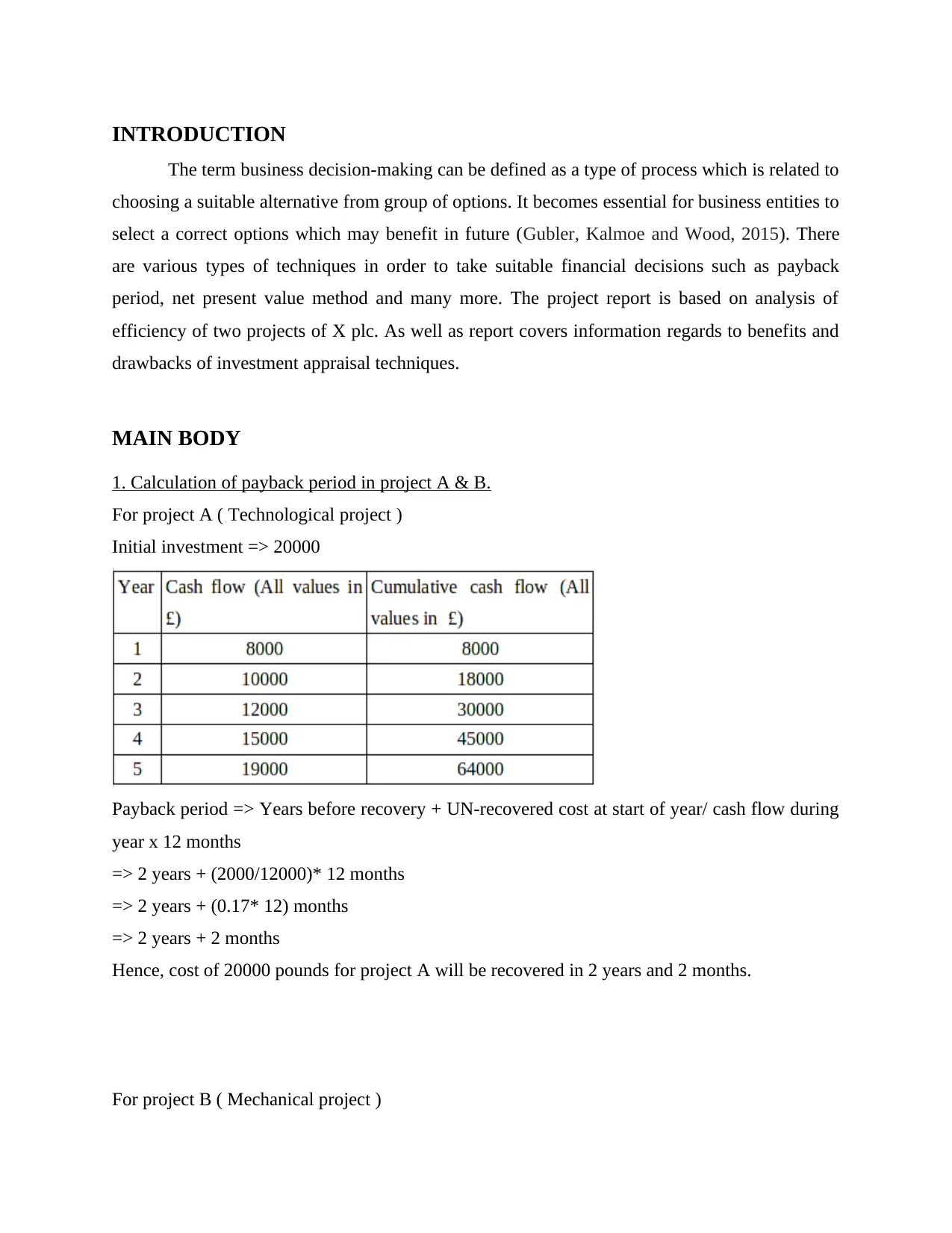
INTRODUCTION
The term business decision-making can be defined as a type of process which is related to
choosing a suitable alternative from group of options. It becomes essential for business entities to
select a correct options which may benefit in future (Gubler, Kalmoe and Wood, 2015). There
are various types of techniques in order to take suitable financial decisions such as payback
period, net present value method and many more. The project report is based on analysis of
efficiency of two projects of X plc. As well as report covers information regards to benefits and
drawbacks of investment appraisal techniques.
MAIN BODY
1. Calculation of payback period in project A & B.
For project A ( Technological project )
Initial investment => 20000
Payback period => Years before recovery + UN-recovered cost at start of year/ cash flow during
year x 12 months
=> 2 years + (2000/12000)* 12 months
=> 2 years + (0.17* 12) months
=> 2 years + 2 months
Hence, cost of 20000 pounds for project A will be recovered in 2 years and 2 months.
For project B ( Mechanical project )
The term business decision-making can be defined as a type of process which is related to
choosing a suitable alternative from group of options. It becomes essential for business entities to
select a correct options which may benefit in future (Gubler, Kalmoe and Wood, 2015). There
are various types of techniques in order to take suitable financial decisions such as payback
period, net present value method and many more. The project report is based on analysis of
efficiency of two projects of X plc. As well as report covers information regards to benefits and
drawbacks of investment appraisal techniques.
MAIN BODY
1. Calculation of payback period in project A & B.
For project A ( Technological project )
Initial investment => 20000
Payback period => Years before recovery + UN-recovered cost at start of year/ cash flow during
year x 12 months
=> 2 years + (2000/12000)* 12 months
=> 2 years + (0.17* 12) months
=> 2 years + 2 months
Hence, cost of 20000 pounds for project A will be recovered in 2 years and 2 months.
For project B ( Mechanical project )
⊘ This is a preview!⊘
Do you want full access?
Subscribe today to unlock all pages.

Trusted by 1+ million students worldwide
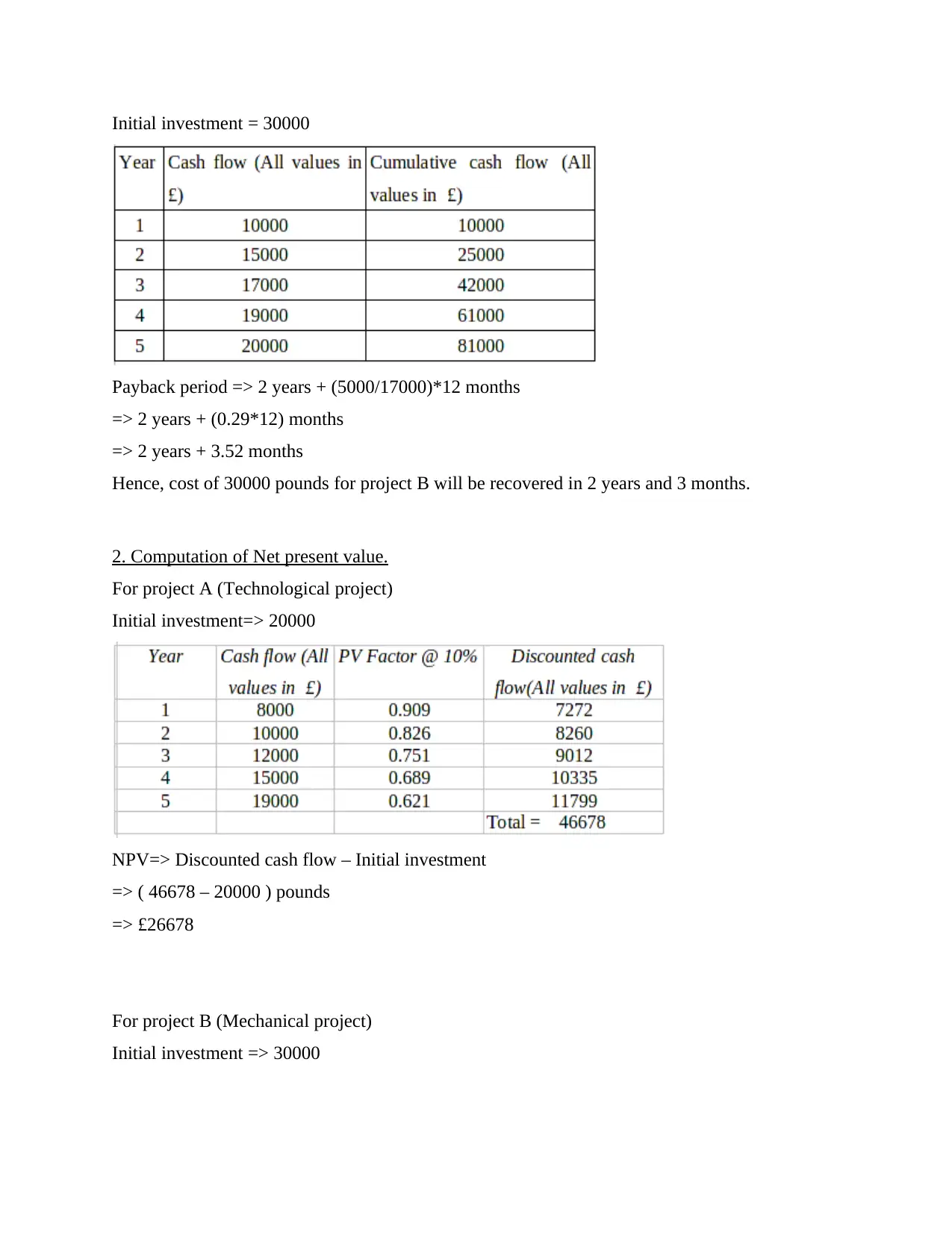
Initial investment = 30000
Payback period => 2 years + (5000/17000)*12 months
=> 2 years + (0.29*12) months
=> 2 years + 3.52 months
Hence, cost of 30000 pounds for project B will be recovered in 2 years and 3 months.
2. Computation of Net present value.
For project A (Technological project)
Initial investment=> 20000
NPV=> Discounted cash flow – Initial investment
=> ( 46678 – 20000 ) pounds
=> £26678
For project B (Mechanical project)
Initial investment => 30000
Payback period => 2 years + (5000/17000)*12 months
=> 2 years + (0.29*12) months
=> 2 years + 3.52 months
Hence, cost of 30000 pounds for project B will be recovered in 2 years and 3 months.
2. Computation of Net present value.
For project A (Technological project)
Initial investment=> 20000
NPV=> Discounted cash flow – Initial investment
=> ( 46678 – 20000 ) pounds
=> £26678
For project B (Mechanical project)
Initial investment => 30000
Paraphrase This Document
Need a fresh take? Get an instant paraphrase of this document with our AI Paraphraser
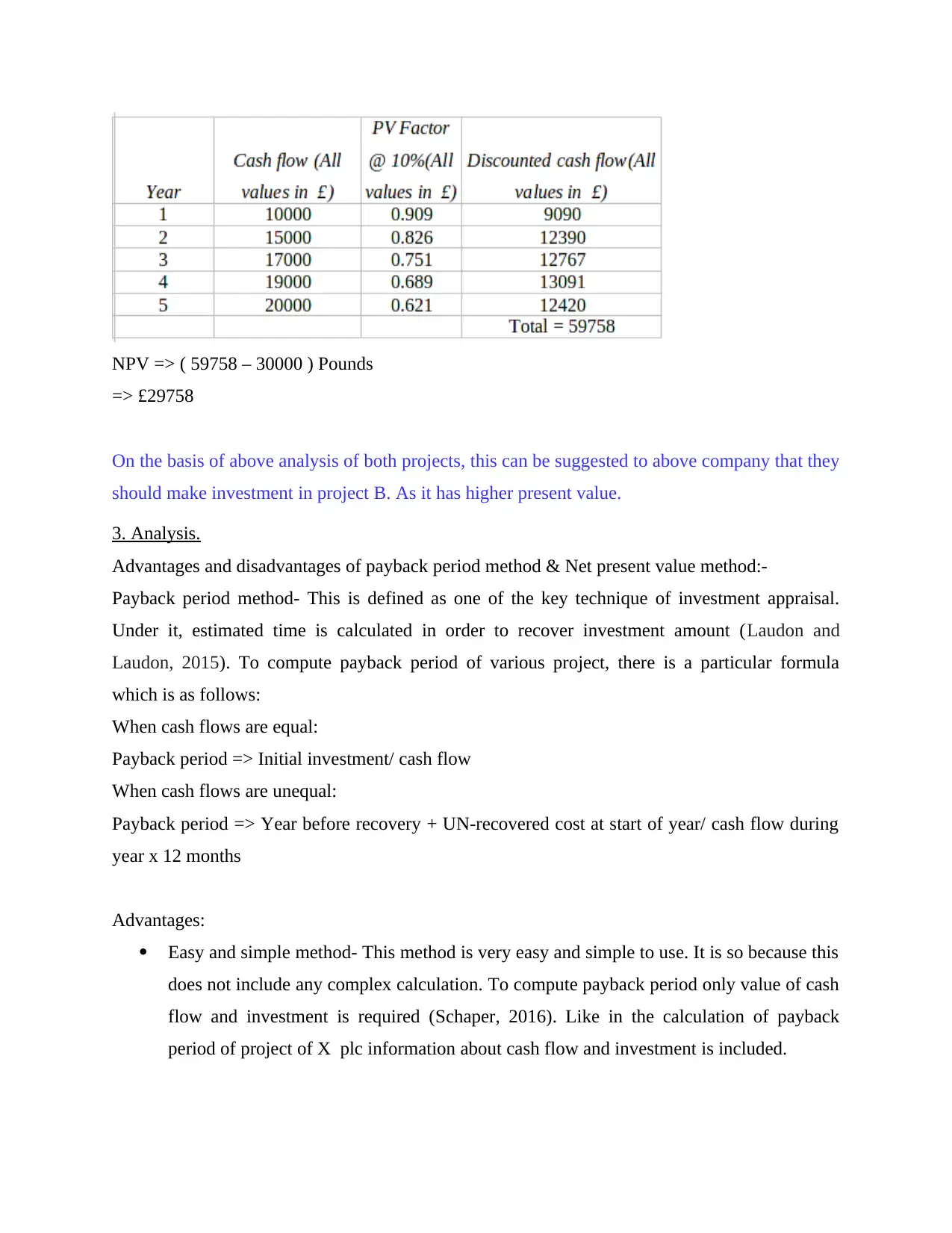
NPV => ( 59758 – 30000 ) Pounds
=> £29758
On the basis of above analysis of both projects, this can be suggested to above company that they
should make investment in project B. As it has higher present value.
3. Analysis.
Advantages and disadvantages of payback period method & Net present value method:-
Payback period method- This is defined as one of the key technique of investment appraisal.
Under it, estimated time is calculated in order to recover investment amount (Laudon and
Laudon, 2015). To compute payback period of various project, there is a particular formula
which is as follows:
When cash flows are equal:
Payback period => Initial investment/ cash flow
When cash flows are unequal:
Payback period => Year before recovery + UN-recovered cost at start of year/ cash flow during
year x 12 months
Advantages:
Easy and simple method- This method is very easy and simple to use. It is so because this
does not include any complex calculation. To compute payback period only value of cash
flow and investment is required (Schaper, 2016). Like in the calculation of payback
period of project of X plc information about cash flow and investment is included.
=> £29758
On the basis of above analysis of both projects, this can be suggested to above company that they
should make investment in project B. As it has higher present value.
3. Analysis.
Advantages and disadvantages of payback period method & Net present value method:-
Payback period method- This is defined as one of the key technique of investment appraisal.
Under it, estimated time is calculated in order to recover investment amount (Laudon and
Laudon, 2015). To compute payback period of various project, there is a particular formula
which is as follows:
When cash flows are equal:
Payback period => Initial investment/ cash flow
When cash flows are unequal:
Payback period => Year before recovery + UN-recovered cost at start of year/ cash flow during
year x 12 months
Advantages:
Easy and simple method- This method is very easy and simple to use. It is so because this
does not include any complex calculation. To compute payback period only value of cash
flow and investment is required (Schaper, 2016). Like in the calculation of payback
period of project of X plc information about cash flow and investment is included.

Ranking of projects- In addition, it is useful for companies for arranging projects in a
rank as per the efficiency of projects. Due to this it becomes easier for managers to take
correct decisions about making investment.
Disadvantages:
Ignores annual cash flow- Payback period method consider only those cash flows till that
investment amount recovered. After that, it does not focus on rest of cash flows which is
a huge issue (Strauss, Kristandl and Quinn, 2015).
Overlooks capital cost- Under this method, capital cost is ignored which makes produced
results wrong and unrealistic. It considers only cash flows and investment amount.
Net present value- It can be defined as a type of method of investment appraisal in which current
value of projects is evaluated. In order to compute net present value of project, amount of initial
investment is deducted from discounted cash flow.
Advantages:
One of the key benefit of this technique is that under it cost of capital factor and risk
factor is considered which makes results more reliable (Kuziemsky, 2016).
As well as this technique is based on a basic idea that futuristic value of dollar is worth
less in compare to value of dollar in present time.
Disadvantages:
One of the key issue of NPV model is that it needs some assumption regards to cost of
capital of project.
In addition, this method is not useful for making comparison of two projects whose size
is different from each other.
Financial and non financial factors:
1. Financial factor-
Profit- It is a key factor which can impact to any particular project or stakeholders
(Larrick and Feiler, 2015). This is so because if there will be higher profit then projects
are being accepted easily by companies.
rank as per the efficiency of projects. Due to this it becomes easier for managers to take
correct decisions about making investment.
Disadvantages:
Ignores annual cash flow- Payback period method consider only those cash flows till that
investment amount recovered. After that, it does not focus on rest of cash flows which is
a huge issue (Strauss, Kristandl and Quinn, 2015).
Overlooks capital cost- Under this method, capital cost is ignored which makes produced
results wrong and unrealistic. It considers only cash flows and investment amount.
Net present value- It can be defined as a type of method of investment appraisal in which current
value of projects is evaluated. In order to compute net present value of project, amount of initial
investment is deducted from discounted cash flow.
Advantages:
One of the key benefit of this technique is that under it cost of capital factor and risk
factor is considered which makes results more reliable (Kuziemsky, 2016).
As well as this technique is based on a basic idea that futuristic value of dollar is worth
less in compare to value of dollar in present time.
Disadvantages:
One of the key issue of NPV model is that it needs some assumption regards to cost of
capital of project.
In addition, this method is not useful for making comparison of two projects whose size
is different from each other.
Financial and non financial factors:
1. Financial factor-
Profit- It is a key factor which can impact to any particular project or stakeholders
(Larrick and Feiler, 2015). This is so because if there will be higher profit then projects
are being accepted easily by companies.
⊘ This is a preview!⊘
Do you want full access?
Subscribe today to unlock all pages.

Trusted by 1+ million students worldwide
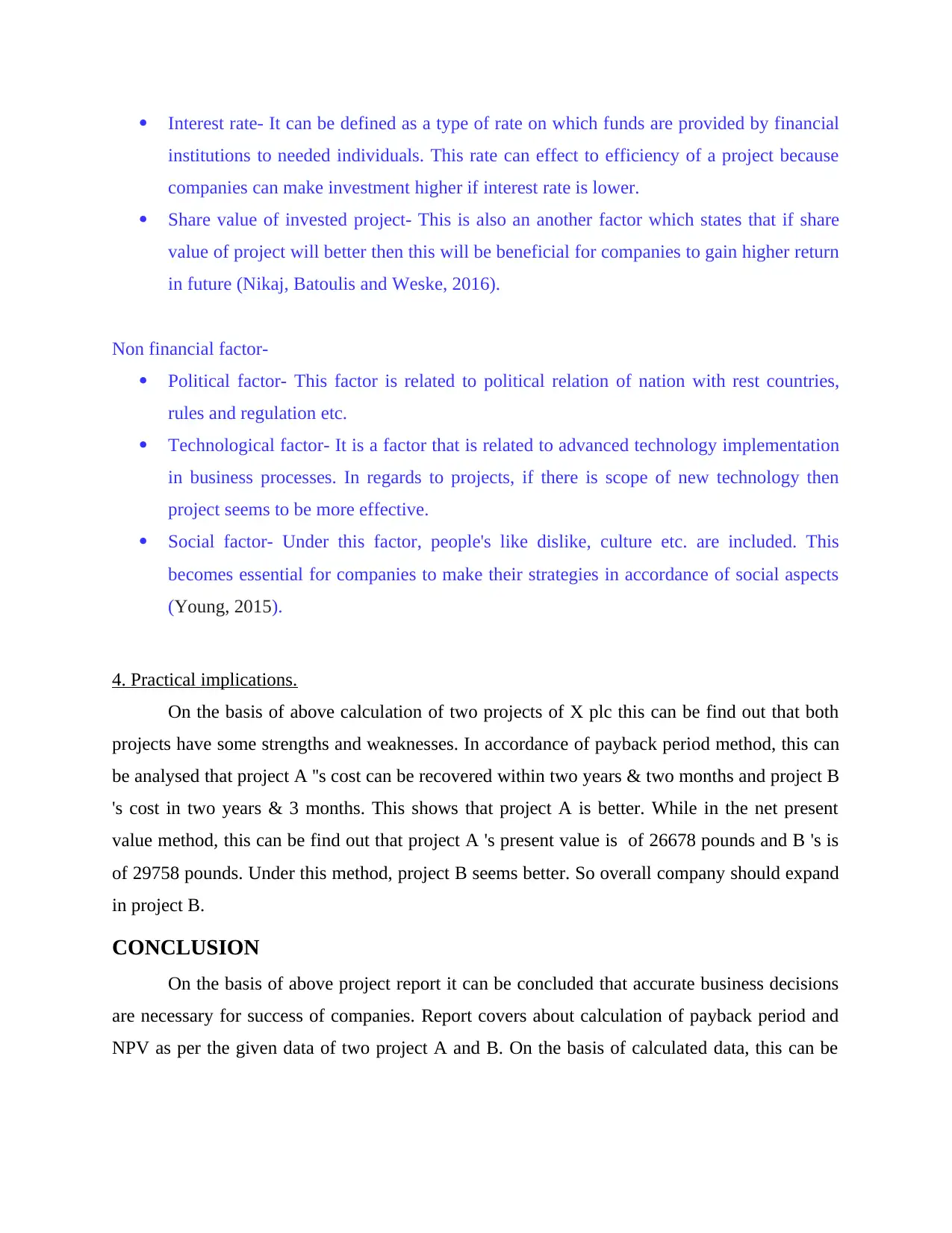
Interest rate- It can be defined as a type of rate on which funds are provided by financial
institutions to needed individuals. This rate can effect to efficiency of a project because
companies can make investment higher if interest rate is lower.
Share value of invested project- This is also an another factor which states that if share
value of project will better then this will be beneficial for companies to gain higher return
in future (Nikaj, Batoulis and Weske, 2016).
Non financial factor-
Political factor- This factor is related to political relation of nation with rest countries,
rules and regulation etc.
Technological factor- It is a factor that is related to advanced technology implementation
in business processes. In regards to projects, if there is scope of new technology then
project seems to be more effective.
Social factor- Under this factor, people's like dislike, culture etc. are included. This
becomes essential for companies to make their strategies in accordance of social aspects
(Young, 2015).
4. Practical implications.
On the basis of above calculation of two projects of X plc this can be find out that both
projects have some strengths and weaknesses. In accordance of payback period method, this can
be analysed that project A ''s cost can be recovered within two years & two months and project B
's cost in two years & 3 months. This shows that project A is better. While in the net present
value method, this can be find out that project A 's present value is of 26678 pounds and B 's is
of 29758 pounds. Under this method, project B seems better. So overall company should expand
in project B.
CONCLUSION
On the basis of above project report it can be concluded that accurate business decisions
are necessary for success of companies. Report covers about calculation of payback period and
NPV as per the given data of two project A and B. On the basis of calculated data, this can be
institutions to needed individuals. This rate can effect to efficiency of a project because
companies can make investment higher if interest rate is lower.
Share value of invested project- This is also an another factor which states that if share
value of project will better then this will be beneficial for companies to gain higher return
in future (Nikaj, Batoulis and Weske, 2016).
Non financial factor-
Political factor- This factor is related to political relation of nation with rest countries,
rules and regulation etc.
Technological factor- It is a factor that is related to advanced technology implementation
in business processes. In regards to projects, if there is scope of new technology then
project seems to be more effective.
Social factor- Under this factor, people's like dislike, culture etc. are included. This
becomes essential for companies to make their strategies in accordance of social aspects
(Young, 2015).
4. Practical implications.
On the basis of above calculation of two projects of X plc this can be find out that both
projects have some strengths and weaknesses. In accordance of payback period method, this can
be analysed that project A ''s cost can be recovered within two years & two months and project B
's cost in two years & 3 months. This shows that project A is better. While in the net present
value method, this can be find out that project A 's present value is of 26678 pounds and B 's is
of 29758 pounds. Under this method, project B seems better. So overall company should expand
in project B.
CONCLUSION
On the basis of above project report it can be concluded that accurate business decisions
are necessary for success of companies. Report covers about calculation of payback period and
NPV as per the given data of two project A and B. On the basis of calculated data, this can be
Paraphrase This Document
Need a fresh take? Get an instant paraphrase of this document with our AI Paraphraser

concluded that project B is better. As well as in the end part of report, benefits and drawbacks of
both investment appraisal techniques is concluded.
both investment appraisal techniques is concluded.
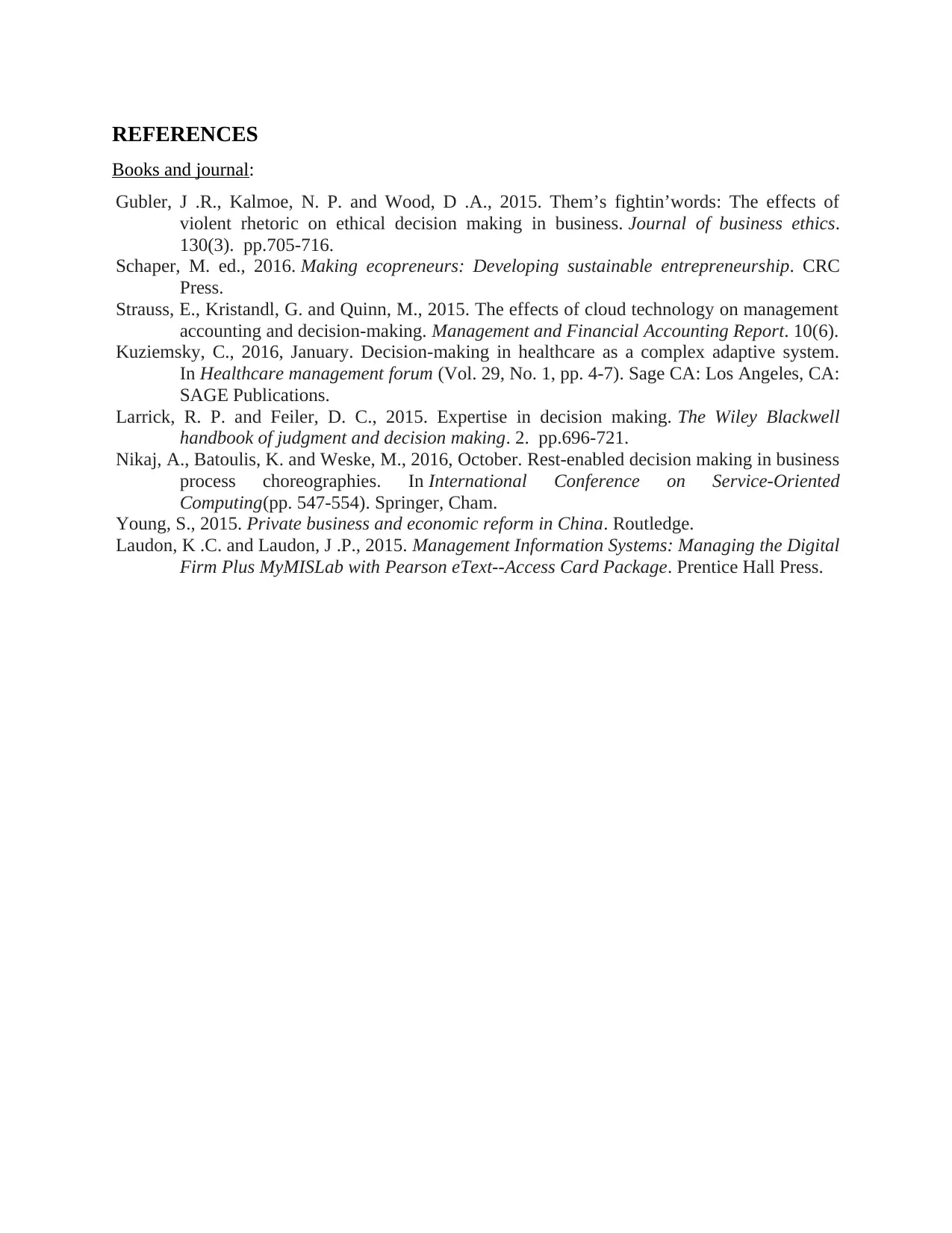
REFERENCES
Books and journal:
Gubler, J .R., Kalmoe, N. P. and Wood, D .A., 2015. Them’s fightin’words: The effects of
violent rhetoric on ethical decision making in business. Journal of business ethics.
130(3). pp.705-716.
Schaper, M. ed., 2016. Making ecopreneurs: Developing sustainable entrepreneurship. CRC
Press.
Strauss, E., Kristandl, G. and Quinn, M., 2015. The effects of cloud technology on management
accounting and decision-making. Management and Financial Accounting Report. 10(6).
Kuziemsky, C., 2016, January. Decision-making in healthcare as a complex adaptive system.
In Healthcare management forum (Vol. 29, No. 1, pp. 4-7). Sage CA: Los Angeles, CA:
SAGE Publications.
Larrick, R. P. and Feiler, D. C., 2015. Expertise in decision making. The Wiley Blackwell
handbook of judgment and decision making. 2. pp.696-721.
Nikaj, A., Batoulis, K. and Weske, M., 2016, October. Rest-enabled decision making in business
process choreographies. In International Conference on Service-Oriented
Computing(pp. 547-554). Springer, Cham.
Young, S., 2015. Private business and economic reform in China. Routledge.
Laudon, K .C. and Laudon, J .P., 2015. Management Information Systems: Managing the Digital
Firm Plus MyMISLab with Pearson eText--Access Card Package. Prentice Hall Press.
Books and journal:
Gubler, J .R., Kalmoe, N. P. and Wood, D .A., 2015. Them’s fightin’words: The effects of
violent rhetoric on ethical decision making in business. Journal of business ethics.
130(3). pp.705-716.
Schaper, M. ed., 2016. Making ecopreneurs: Developing sustainable entrepreneurship. CRC
Press.
Strauss, E., Kristandl, G. and Quinn, M., 2015. The effects of cloud technology on management
accounting and decision-making. Management and Financial Accounting Report. 10(6).
Kuziemsky, C., 2016, January. Decision-making in healthcare as a complex adaptive system.
In Healthcare management forum (Vol. 29, No. 1, pp. 4-7). Sage CA: Los Angeles, CA:
SAGE Publications.
Larrick, R. P. and Feiler, D. C., 2015. Expertise in decision making. The Wiley Blackwell
handbook of judgment and decision making. 2. pp.696-721.
Nikaj, A., Batoulis, K. and Weske, M., 2016, October. Rest-enabled decision making in business
process choreographies. In International Conference on Service-Oriented
Computing(pp. 547-554). Springer, Cham.
Young, S., 2015. Private business and economic reform in China. Routledge.
Laudon, K .C. and Laudon, J .P., 2015. Management Information Systems: Managing the Digital
Firm Plus MyMISLab with Pearson eText--Access Card Package. Prentice Hall Press.
⊘ This is a preview!⊘
Do you want full access?
Subscribe today to unlock all pages.

Trusted by 1+ million students worldwide
1 out of 9
Related Documents
Your All-in-One AI-Powered Toolkit for Academic Success.
+13062052269
info@desklib.com
Available 24*7 on WhatsApp / Email
![[object Object]](/_next/static/media/star-bottom.7253800d.svg)
Unlock your academic potential
Copyright © 2020–2025 A2Z Services. All Rights Reserved. Developed and managed by ZUCOL.





